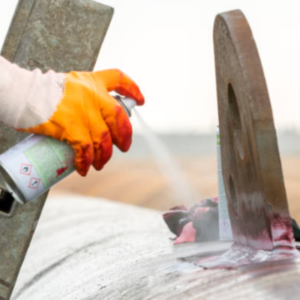Radiography testing (RT) is one of the most widely used non-destructive test (NDT) methods. With the help of this method, we can detect hidden flaws or discontinuities present in welds such as cracks, porosity & blowholes, slag, flux or oxide inclusions, lack of fusion, incomplete penetration, Mismatch, and tungsten inclusion, etc.
Short wavelength electromagnetic radiations such as X-rays or Gamma (γ) rays are used for Radiography testing. Both X-rays and Gamma rays have very high intensity and hence they are able to penetrate the material of any thickness. This high penetrating power is used during radiography testing.
The part to be inspected (Test material) is placed between the radiation source and a sensitive film. If the material is sound or flawless, entire rays (either X-rays or Gamma rays) pass through the material very evenly. But if the material contains any flaw (or flaws), then some of the rays which will pass through the flaws will get absorbed to some extent due to the change in the density. Please note that those rays which will not encounter any flaw will remain intact and will pass through the material evenly. These rays are finally made to fall on a light-sensitive film placed on the backside of the material being inspected.
The material (being inspected) and the sensitive film are kept under exposure to radiation (either X-rays or Gamma rays) for a certain period of time then the film is developed. Once the film is developed, it is called a radiograph.
The density of the film or the amount of darkness on the film will vary depending upon the amount of radiation reaching the film. The darker area on a radiograph indicates more exposure (higher radiation intensity) as compared to the lighter areas which receive less exposure. This variation in the image darkness reveals the presence of flaws or discontinuity inside the film. This variation in the darkness may also be used to determine the thickness or composition of the test material.
Please note that most of the defects possess lesser density than the sound parent metal, hence they transmit radiation (either X-rays or Gamma rays) much better than the sound metal does. Hence the film appears to be darker at the area exposed by the defects.
As explained earlier that both X-rays and Gamma rays are electromagnetic radiation having short wavelengths but very high intensity, now we will learn the steps to be followed for performing the Radiography Test.
Radiography by using X-rays:
X-rays are produced by an X-ray tube, which is an evacuated tube (usually made of glass) and it contains an electrically heated filament and a tungsten anode. The electrically heated filament releases electrons which are made to hit on the tungsten anode. Due to the collision of high-velocity electrons with the tungsten anode, X-rays are emitted.
These X-rays are allowed to pass through the test material. A cassette containing film is placed behind the test material (part to be inspected). A penetrameter (or Image Quality Indicator IQI) is placed on the side of the source adjacent to the weld.
After the prescribed time of exposure, the source is turned off and the film is sent for development in the darkroom (A darkroom is a place where the film is developed. Click here to learn how the film is developed in the darkroom). After development, the film is inspected with the help of a viewer.
Radiography by using Gamma-rays:
Gamma rays are produced by radioactive isotopes. The nucleus of a radioactive isotope remains unstable. Commonly used isotopes for industrial radiography are:
- Cobalt 60 (Co 60): Half-life of 5.3 years
- Iridium 192 (Ir192): Half-life of 72 days
- Caesium-137 (Cs137) : Half-life of 30 yearsA lead or tungsten alloy container of sufficient thickness is used containing the gamma-ray source (300 mg). Such containers are used to provide the necessary protection. These Gamma rays are allowed to pass through the test material. A cassette containing film is placed behind the test material (part to be inspected). A penetrameter (or Image Quality Indicator IQI) is placed on the side of the source adjacent to the weld. The rest of the procedures is the same as the X-ray technique..
Watch a video now

















المراجعات
لا توجد مراجعات بعد.